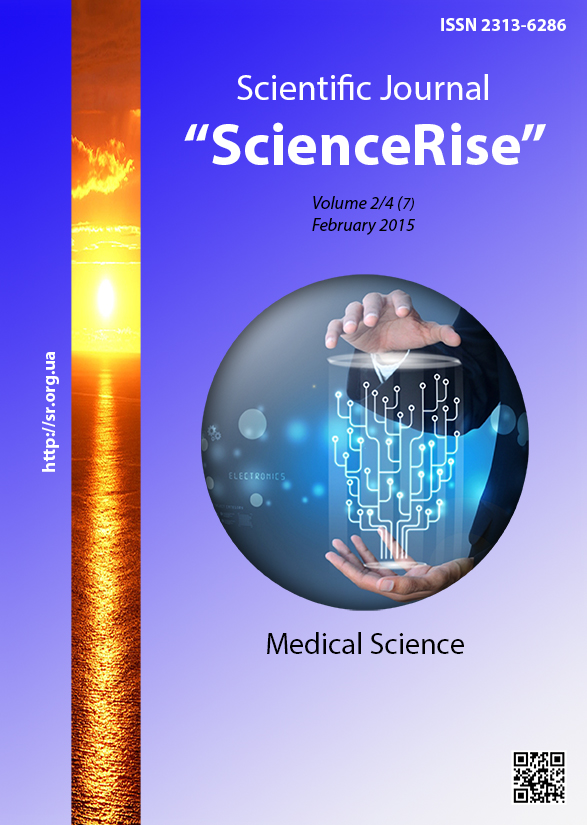Myocardial viability assessment after revascularization in patients with coronary heart disease
DOI:
https://doi.org/10.15587/2313-8416.2015.37886Keywords:
myocardial viability, stunned, hibernating myocardium, myocardial revascularizationAbstract
Some aspects of the definition of medical tactics relating to the definition of myocardial viability before revascularization in patients with coronary heart disease are considered in detail in the article.
Methods. A total of 65 patients with CHD, including 20 patients with type 2 diabetes are examined. The presence and severity of coronary artery lesion was performed by coronary angiography. Subsequent percutaneous coronary intervention (PCI) was performed in 32 patients. Strain echocardiography is made for all patients before PCI and one year after PCI.
Result. According to coronary angiography in patients with CHD and type 2 diabetes in 25 % of case registered atherosclerotic lesions of a coronary artery and a 45 % loss of two or three coronary arteries, compared with 40 % and 20 %, respectively, in patients with CHD without type 2 diabetes (p˂0.05). Number of abnormal segments, restore function one year after PCI in the first group was significantly lower than in the second group (27 % vs 35 %). Assessment of left ventricular myocardial contractile function 1 year after revascularization showed that the recovery of the longitudinal (LongS, %), radial (RadS, %) and circular (CircS, %) strain in patients of group 1 is expressed to a much lesser extent.
Conclusions. In patients with decreased global LV contractility requires assessment of myocardial viability is necessary before myocardial revascularization to confirm its feasibility. The presence of type 2 diabetes slows recovery of viable myocardium after revascularization compared with patients without diabetes. Carrying the strain echocardiography before and after myocardial revascularization is justified to assess the recovery of myocardial contractility
References
Nichols, M., Townsend, N., Scarborough, P., Rayner, M. (2014). Cardiovascular disease in Europe 2014: epidemiological update. European Heart Journal, 34 (42), 3028–3034. doi: 10.1093/eurheartj/ehu299
Head, S. J., Kaul, S., Mack, M. J., Serruys, P. W., Taggart, D. P., Holmes, D. R., Leon, M. B., Marco, J., Bogers, A. J. J. C., Kappetein, A. P. (2013). The rationale for Heart Team decision-making for patients with stable, complex coronary artery disease. European Heart Journal, 34 (32), 2510–2518. doi: 10.1093/eurheartj/eht059
The Task Force on Myocardial Revascularization of the European Society of Cardiology (ESC) and the European Association for Cardio-Thoracic Surgery (EACTS) (2014) ESC/EACTS Guidelines on myocardial revascularization. European Heart Journal, 35 (35), 2383–2431.
Long, J., Long, H., Luckraz, J., Thekkudan, A., Maher, M. (2012). Norell Heart Team discussion in managing patients with coronary artery disease: outcome and reproducibility 14 (5), 594–598. doi: 10.1093/icvts/ivr157
Sawada, S., Sawada, S., Dasgupta, S., Nguyen, J. (2010). Effect of revascularization on longterm survival in patients with ischemic left ventricular dysfunction and a wide range of viability. American Journal of Cardiology, 106 (5), 187–192. doi: 10.1016/j.amjcard.2010.03.014
Schinkel, A., Poldermans, D., Elhendy, A., Jeroen, J. (2007). Assessment of Myocardial Viability in Patients with Heart Failure. The journal of nuclear medicine, 48 (7), 1135–1146. doi: 10.2967/jnumed.106.038851
Cleland, J. G. F., Calvert, M., Freemantle, N., Arrow, Y., Ball, S. G., Bonser, R. S. et. al. (2011). The Heart Failure Revascularisation Trial (HEART). European Journal of Heart Failure, 13 (2), 227–233. doi: 10.1093/eurjhf/hfq230
Windecker, S., Stortecky, S., Stefanini, G. G., daCosta, B. R., Rutjes, A. W., Di Nisio, M. et. al. (2014). Revascularisation versus medical treatment in patients with stable coronary artery disease: network meta-analysis. British Medical Journal, 348 (jun23), g3859. doi: 10.1136/bmj.g3859
Allman, K., Shaw, L., Hachamovitch, R., Udelson, J. (2002). Myocardial viability testing and impact of revascularization on prognosis in patients with coronary artery disease and left ventricular dysfunction: a meta-analysis. The Journal of the American College of Cardiology, 39 (7), 1151–1158. doi: 10.1016/s0735-1097(02)01726-6
Velazquez, E. J., Lee, K. L., O’Connor, C. M., Oh, J. K., Bonow, R. O., Pohost, G. M. et. al. (2007). The rationale and design of the Surgical Treatment for Ischemic Heart Failure (STICH) trial. The Journal of Thoracic and Cardiovascular Surgery, 134 (6), 1540–1547. doi: 10.1016/j.jtcvs.2007.05.069
Bonow, R., Maurer, O., Lee, K. (2011). Myocardial Viability and Survival in Ischemic Left Ventricular Dysfunction. New England Journal of Medicine, 364, 1617–1625.
Downloads
Published
Issue
Section
License
Copyright (c) 2015 Игорь Владимирович Кузнецов

This work is licensed under a Creative Commons Attribution 4.0 International License.
Our journal abides by the Creative Commons CC BY copyright rights and permissions for open access journals.
Authors, who are published in this journal, agree to the following conditions:
1. The authors reserve the right to authorship of the work and pass the first publication right of this work to the journal under the terms of a Creative Commons CC BY, which allows others to freely distribute the published research with the obligatory reference to the authors of the original work and the first publication of the work in this journal.
2. The authors have the right to conclude separate supplement agreements that relate to non-exclusive work distribution in the form in which it has been published by the journal (for example, to upload the work to the online storage of the journal or publish it as part of a monograph), provided that the reference to the first publication of the work in this journal is included.

